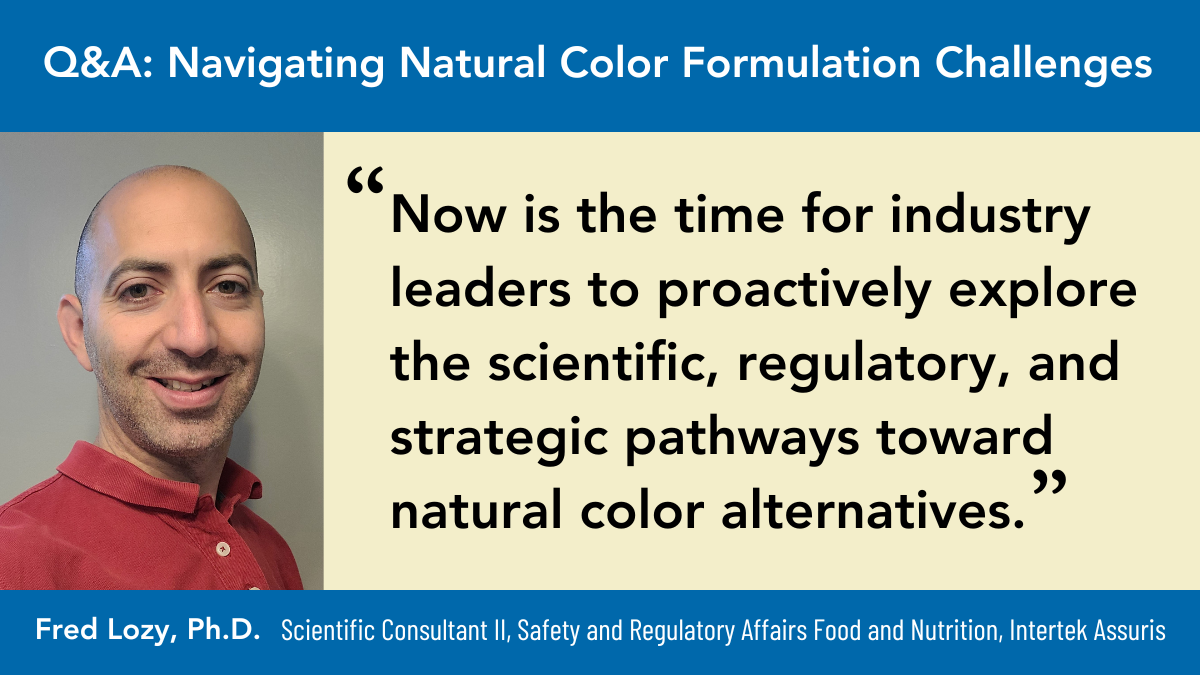Q&A with Fred Lozy, Ph.D., Scientific Consultant II, Safety and Regulatory Affairs Food and Nutrition, Intertek Assuris
Q: How does Intertek Assuris support companies who are navigating regulatory and safety challenges in the dietary supplement and functional food industry?
Fred: We provide customized solutions, delivering cost-effective and efficient strategies to achieve regulatory compliance. Our scientific and regulatory experts have decades of experience in the dietary supplement and functional food industries specializing in pre-market clearance for ingredients in the form of new dietary ingredient notifications (NDINs), Generally Recognized as Safe (GRAS) dossiers, food and color additive petitions, novel and functional food applications, and claims substantiation. Not only do we specialize in the U.S. market but also have the capability of ensuring products are regulatory compliant in global markets, including Europe, the United Kingdom, Australia/New Zealand, Canada, and the APAC region. We offer a range of services including regulatory compliance consulting, scientific evaluations, and safety assessments depending on the needs of our clients whether they are in product development or preparing to enter the market.
Q: Can you explain the difference between a “natural color” and a “synthetic color” from a regulatory standpoint in the U.S.?
Fred: Chapter VII, Section 721 of the Federal Food, Drug, and Cosmetic Act (FFDCA) authorizes the FDA to approve color additives for use in foods (including dietary supplements), drugs, and cosmetics. The Color Additive Amendments of 1960 define a color additive as “any material... when added or applied to a food, drug, or cosmetic... is capable (alone or through reaction with another substance) of imparting color thereto,” and require that such additives be proven safe and suitable for their intended use.
Recently, the FDA announced its intent to ban and phase out certain synthetic color additives—such as Citrus Red No. 2 and FD&C Yellow No. 5—which are typically synthesized from petrochemical sources like benzene and naphthalene. In their place, the Agency is encouraging the adoption of naturally derived alternatives, as reflected in recent approvals of Galdieria extract blue, butterfly pea extract, and calcium phosphate.
Although there is no formal regulatory definition distinguishing “natural” from “synthetic” colors, 21 CFR Parts 73 and 74 classify color additives into two categories: certified color additives, which require FDA batch certification due to potential toxicological impurities, and color additives exempt from certification, which are generally derived from natural sources such as vegetables, minerals, or animals. According to FDA guidance, synthetic colors typically fall under the category requiring certification, while naturally sourced colors are usually exempt.
Q: How do companies navigate formulation challenges when transitioning from synthetic to natural colors?
Fred: To use a substance as a color additive in food, it must first be approved by the FDA through the Color Additive Petition (CAP) process. This process establishes the types of foods in which the additive may be used, the maximum allowable usage levels, and how it must be declared on product labeling. Intertek offers deep expertise and a strong working relationship with the FDA to help companies navigate the CAP process, particularly for color additives derived from natural sources. Our team provides end-to-end support, including safety evaluations related to sourcing, production methods, and intended use levels, ensuring regulatory compliance and strategic alignment throughout development.
Q: What regulatory or supply chain considerations should companies weigh before switching to naturally derived colorants?
Fred: For any color additive, safety is paramount when considering the regulatory hurdles a company may face when switching to naturally derived colors. Companies looking to make the switch can often avoid costly and time-intensive toxicology and safety studies if the color source has a well-established history of safe consumption within the U.S. market. However, ensuring product purity is just as critical. Companies must be vigilant in confirming that naturally derived colors are free from environmental contaminants or impurities introduced during processing.
Q: With growing scrutiny over certain synthetic color additives, what steps should companies take to prepare for potential bans or restrictions?
Fred: With growing scrutiny over certain synthetic color additives, companies using these in foods, beverages, and dietary supplements should be proactive and evaluate how a potential ban or restriction will affect their products from both a regulatory compliance and public perception standpoint. Companies should monitor regulatory trends as state, federal and global agencies may implement changes at different rates. Additionally, companies will need to consider whether natural options are possible from a supplier standpoint and how these options would affect color, stability, and functional performance of their products. Natural alternatives like annatto, beet juice extract, or spirulina may require reformulation or matrix adjustments. Labeling and marketing compliance teams will need to ensure conformity with federal and global regulatory requirements. Lastly, communication with stakeholders including regulators, retailers, and consumers will be crucial to build trust and avoid public criticism.
Q: If there’s one takeaway you’d like industry leaders to keep in mind when approaching color additive reformulation or compliance, what would it be?
Fred: Forward-thinking brands in the food and supplement industry must look beyond regulatory compliance when addressing the growing movement to eliminate synthetic colors. Public perception and brand reputation are just as critical—if not more so—in shaping long-term success. While the safety of synthetic colors remains a topic of scientific and regulatory debate, it’s ultimately the consumer who will decide what they will consume. Now is the time for industry leaders to proactively explore the scientific, regulatory, and strategic pathways toward natural color alternatives.


